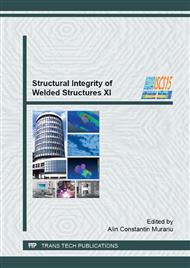[1]
Camelia, Szuhanek, Biomechanical comparation between tipping forces effect in labial and lingual orthodontics. Proc. Congress European Society of Lingual Orthodontics, Cannes, Franta, 2008, 4-8 iulie, pp.245-250.
Google Scholar
[2]
C. Bertrand et. al., The laser welding technique applied to the non precious dental alloys procedure and results. In: Br. Dent J. 2001 Mar 10; 190(5), pp.255-257.
DOI: 10.1038/sj.bdj.4800942a
Google Scholar
[3]
T. Haas, A. Schuessler, Welding and Joining of TiNi Shape Memory Alloys: Engineering Aspects and Medical Applications. Proc. First European Conference on Shape and Superelastic Technologies SMST-99. Antwerp Zoo, Belgium, September 5-9, (1999).
Google Scholar
[4]
C. Bertrand, et. al., Optimization of operator and physical parameters for laser welding of dental materials. In: Br Dent J. 2004 Apr. 10; 196(7), pp.413-418.
DOI: 10.1038/sj.bdj.4811138
Google Scholar
[5]
V., Bardeanu, et. al., Using laser to repair partial dentures movable skeletons. Proc. Internat. Conf. TIMA, ISIM Timisoara, iuny (2007).
Google Scholar
[6]
x x x Laser welding in orthodontics Herbst IV (REF 607-115-00). Dentaurum. 989-629-20.
Google Scholar
[7]
Camelia Szuhanek, et. al., The influence of welding method on mechanical properties of orthodontic metal appliances. RADMI Conf., sept. 2010, Donji Milanovac, Serbia.
Google Scholar
[8]
Camelia Szuhanek, T. Fleser, Research on welded thin NiTi wires and orthodontic bands. Solid State Phenomena Vol. 188 (2012) pp.300-305 © (2012) Trans Tech Publications, Switzerland doi: 10. 4028/www. scientific. net/SSP. 188. 300.
DOI: 10.4028/www.scientific.net/ssp.188.300
Google Scholar
[9]
x x x NiTi Devices & Components 47533 Westinghouse Drive, Fremont, California 94539 (510)683-2000 www. NiTi. com.
Google Scholar
[10]
x x x ANSI/ADA Specification No. 32—Orthodontic Wires.
Google Scholar
[11]
x x x ANSI/ADA Specification No. 88—Dental Brazing Alloys.
Google Scholar
[12]
J., J., Bock, et. al., Influence of different brazing and welding methods on tensile strength and microhardness of orthodontic stainless steel wire. European J. of Orth. 30 (2008).
DOI: 10.1093/ejo/cjn022
Google Scholar
[13]
P. Schwada, Designing with Advanced Materials: Joining NiTi to NiTi. Medical Design, Mar 1, (2007).
Google Scholar
[14]
V. Delobelle, Contributions à l'étude thermomécanique des alliages à mémoire de forme NiTi et à la réalisation par soudage de matériaux architecturés NiTi. Favier, Denis; Grenoble. 2012. 12. 13 http: /www. theses. fr/2012GRENI099/document.
Google Scholar
[17]
J., J., Bock, s. a. Fracture strength of different soldered and welded orthodontic joining configurations with and without filling material. Journal of Applied Oral Science. vol. 16, no. 5 Bauru Sept. /Oct. 2008. ISSN1678-7757.
DOI: 10.1590/s1678-77572008000500005
Google Scholar


